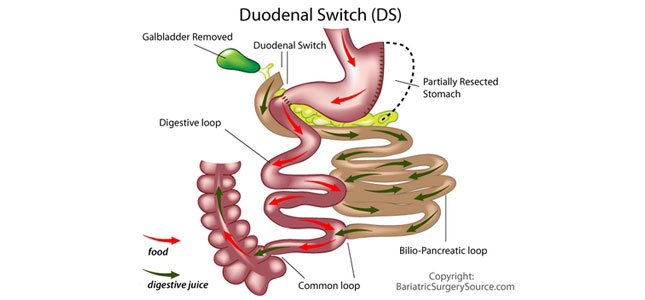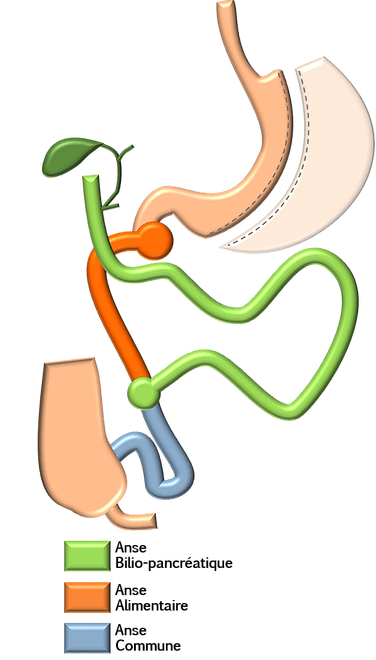Principles
This intervention create a reduction in gastric capacity but however can also cause significant malabsorption problems. It consists of two surgical acts that can be performed simultaneously or several months apart (12 to 18 months) which has the advantage of reducing the risk of immediate complications especially in cases of massive obesity (BMI – 60 kg/m2).
The first phase, less complex than the second, is to do a sleeve gastrectomy to reduce the volume of the stomach.

The second phase is more complex. It consists of modifying the digestive tract in order to create two circuits; one for the passage of food and the other for the passage of digestive juices, the two circuits joining at the level of terminal small bowel.
To do this the duodenum is divided 3 cm below the pylorus so as to separate the stomach, pylorus and the first centimetres of the duodenum from the rest of the digestive tract and then the small intestine is divided 250 cm from its opening into the colon.
The lower segment of the small bowel is then connected to the small segment of duodenum left attached to the stomach and the upper segment (bilio-pancreatic loop) is reconnected with the small bowel 1 meter from the opening into the colon.

Small bowell is thus divided into 3 segments: a biliopancreatic loop 3 to 4 meters long through which only the digestive juices pass, a 1.5 m loop through which the food passes and finally a common loop 100 cm long where food mixes with digestive juices for digestion and absorption.
Compared to the Roux-en-Y gastric bypass, this procedure preserves the pylorus, hence a near-zero risk of dumping syndrome. On the other hand the small bowel segment for digested food (common loop) is much shorter. Much of the food passes through the colon without being absorbed, resulting in a significantly higher risk of nutritional deficiencies.
Weight loss is linked to the same mechanisms as after a gastric bypass (Roux-en-Y or Omega) but with much greater risk of malabsorption.

Benefits
-
Greater weight loss than after all other procedures.
-
The most effective procedure for reducing type 2 diabetes and other associated diseases.
-
Preservation of the pylorus therefore no risk of dumping syndrome.
-
Preservation of the first part of the duodenum, resulting in a near-zero risk of ulcers.
-
Can be done in two stages.
Disadvantages
-
The duodenum and bile ducts are inaccessible to endoscopy.
-
This technique exposes you to the risk of mechanical obstructions and internal hernias.
-
Malabsorption requires lifetime supplementation of vitamins and trace elements and can alter the effectiveness of drug treatments.
-
Requires a high-protein diet to prevent undernutrition.
-
Risk of protein malnutrition and or excessive weight loss.
-
Side effects can affect quality of life, including foul smelling gases and stools.
-
In case of long-term weight regain, there are few satisfactory solutions.

